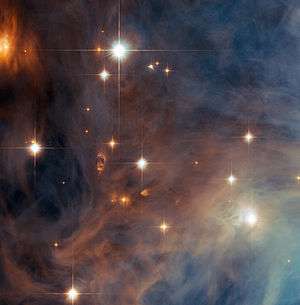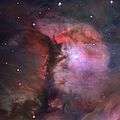Messier 43
Messier 43 or M43, also known as De Mairan's Nebula and NGC 1982, is a star-forming nebula with a prominent H II region in the equatorial constellation of Orion. It was discovered by the French scientist Jean-Jacques Dortous de Mairan some time before 1731,[2] then catalogued by French astronomer Charles Messier on March 4, 1769. The De Mairan's Nebula is part of the Orion Nebula (Messier 42), being separated from the main nebula by a dense lane of dust known as the northeast dark lane.[4] It is part of the much larger Orion Molecular Cloud Complex.
| Emission nebula | |
|---|---|
| H II region | |
 Infrared view of (part of) De Mairan's Nebula (M43) taken by the Wide Field Channel of Hubble’s Advanced Camera for Surveys | |
| Observation data: J2000 epoch | |
| Right ascension | 05h 35m 31.8s[1] |
| Declination | −05° 17′ 57″[1] |
| Distance | 1600 ly |
| Apparent magnitude (V) | +9.0 |
| Apparent dimensions (V) | 20′ × 15′[2] |
| Constellation | Orion |
| Notable features | Trapezium cluster |
| Designations | De Mairan's Nebula, M43, NGC 1982[3] |
The main ionizing star in this nebula is HD 37061 (variable star designation NU Ori), which is positioned near the center of the H II region and located 1,300 ± 160 ly (400 ± 50 pc) from the Sun. This is a triple star system with the brighter component being a single-lined spectroscopic binary. The main component is a blue-white hued B-type main-sequence star with a stellar classification of B0.5V or B1V. It has 19±7 times the mass of the Sun and 5.7±0.8 times the Sun's radius. The star is radiating over 26,000 times the Sun's luminosity from its photosphere at an effective temperature of 31,000 K. It is spinning rapidly with a projected rotational velocity of around 200 km/s.[4]
The H II region is a roundish volume of ionized hydrogen centered on HD 37061. It has a diameter of about 4.5′, corresponding to a linear size of 2.1 ly (0.65 pc). The net hydrogen alpha luminosity of this region is (3.0±1.1)×1035 erg s−1; equivalent to 78 L☉. There is a dark lane crossing in front of the region from north to south, known as the M43 dark lane.[4]
Gallery
References
- Sulentic, Jack W.; et al. (1973), The revised new catalogue of nonstellar astronomical objects, Tucson: University of Arizona Press, Bibcode:1973rncn.book.....S.
- Adam, Len (2018), Imaging the Messier Objects Remotely from Your Laptop, The Patrick Moore Practical Astronomy Series, Springer, p. 209, Bibcode:2018imor.book.....A, ISBN 978-3319653853.
- "M 43". SIMBAD. Centre de données astronomiques de Strasbourg. Retrieved November 25, 2018.
- Simón-Díaz, S.; et al. (June 2011), "A detailed study of the H ii region M 43 and its ionizing star", Astronomy & Astrophysics, 530: 13, arXiv:1103.3628, Bibcode:2011A&A...530A..57S, doi:10.1051/0004-6361/201116608, A57.
External links
| Wikimedia Commons has media related to Messier 43. |
- Garner, Rob, ed. (October 19, 2017), Messier 43, NASA, retrieved 2018-11-26.
- Frommert, Hartmut; Kronberg, Christine (October 8, 2018), Messier 43: De Mairan's Nebula, Companion of the Orion Nebula, Students for the Exploration and Development of Space (SEDS), retrieved 2018-11-26
- Messier 43 on WikiSky: DSS2, SDSS, GALEX, IRAS, Hydrogen α, X-Ray, Astrophoto, Sky Map, Articles and images

